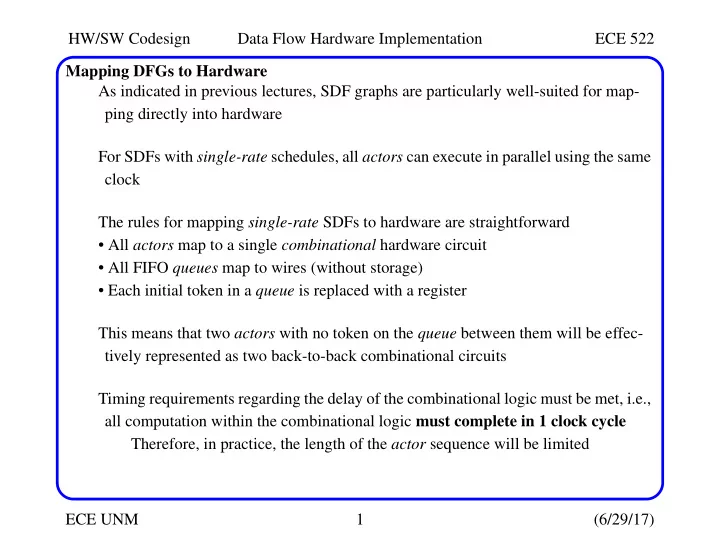

HW/SW Codesign Data Flow Hardware Implementation ECE 522 Mapping DFGs to Hardware As indicated in previous lectures, SDF graphs are particularly well-suited for map- ping directly into hardware For SDFs with single-rate schedules, all actors can execute in parallel using the same clock The rules for mapping single-rate SDFs to hardware are straightforward • All actors map to a single combinational hardware circuit • All FIFO queues map to wires (without storage) • Each initial token in a queue is replaced with a register This means that two actors with no token on the queue between them will be effec- tively represented as two back-to-back combinational circuits Timing requirements regarding the delay of the combinational logic must be met, i.e., all computation within the combinational logic must complete in 1 clock cycle Therefore, in practice, the length of the actor sequence will be limited ECE UNM 1 (6/29/17)
HW/SW Codesign Data Flow Hardware Implementation ECE 522 Mapping DFGs to Hardware The performance annotations we’ve used in DFGs are only estimates of delay Obtaining precise combinational circuit delays falls in the realm of CAD tools We will treat the delay annotations for an actor as the critical path delay , i.e., the delay of the worst-case path in the actor’s combinational circuit Let’s use Euclid’s Greatest Common Divisor algorithm to illustrate the process Euclid’s GCD Algorithm The sort actor reads the two initial token values a and b , sorts them and reproduces them on the output The diff actor subtracts the smallest number from the largest one as long as they are not equal ECE UNM 2 (6/29/17)
HW/SW Codesign Data Flow Hardware Implementation ECE 522 Mapping DFGs to Hardware You should convince yourself that a PASS exists using the techniques described ear- lier for SDFs Following the mapping rules given above, we obtain the following circuit The sort and diff actors are implemented using a comparator, a subtractor plus a few multiplexers Note that the delay through the circuits of both actors define the maximum achiev- able clock frequency If the critical path delays are 5 and 15 ns, then max. operating freq. is 50 MHz ECE UNM 3 (6/29/17)
HW/SW Codesign Data Flow Hardware Implementation ECE 522 Mapping DFGs to Hardware: Pipelining The pipelining transformation discussed earlier is a very popular technique to deal with path delays that limit clock frequency Consider a dataflow specification of a digital filter The filter computes a weighted sum of the samples arriving from the input stream as out = x0 . c2 + x1 . c1 + x2 . c0 multiply actors The critical path of this graph is associated with the one of the multiplier actors , c0 or c1 , in series with two addition actors ECE UNM 4 (6/29/17)
HW/SW Codesign Data Flow Hardware Implementation ECE 522 Mapping DFGs to Hardware: Pipelining Pipeling allows additional tokens to be added (at the expense of increase latency) Here, one is introduced by the in actor And then retiming is used to redistribute the tokens, as shown by the above marking, which is produced after firing c0 , c1 and c2 Retiming creates additional registers and an additional pipeline stage The critical path is now reduced to two back-to-back adder actors ECE UNM 5 (6/29/17)
HW/SW Codesign Data Flow Hardware Implementation ECE 522 Mapping DFGs to Hardware: Pipelining This final marking is obtained by allowing the in actor to add one more token and then using retiming to fire c0 , c1 , c2 and the top add actor The resulting pipelined DFG implementation The schematic on the right shows a fully pipelined implementation Note that it is not possible to introduce arbitrary initial tokens in a graph without fol- lowing the actor’s firing rules Doing so would likely change the behavior of the system ECE UNM 6 (6/29/17)
HW/SW Codesign Data Flow Hardware Implementation ECE 522 Mapping DFGs to Hardware: Pipelining This change in behavior is obvious in the case of feedback loops, as shown here for an accumulator circuit • Using a single token in the feedback loop of an add actor will accumulate all input samples, as shown on the left • Using two tokens in the feedback loop will accumulate the odd samples and even samples separately When pipelining a DFG, be sure to follow the rules for subsequent markings When adding new tokens , add them only at the input or output of the DFG, outside of any loops And then use retiming to redistribute the tokens to reduce critical path delay ECE UNM 7 (6/29/17)
Recommend
More recommend